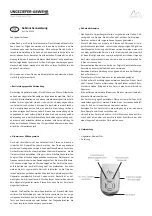
2. Installation and Wiring
2-3
2-3 Precautions for Power Supply and Motor Wiring
DANGER
• Always turn the device's input power OFF before starting wiring.
Failure to do so could lead to electrical shocks or fires.
• Carry out grounding that complies with the standards of the country where the inverter is being
installed.
Failure to do so could lead to electrical shocks or fires.
• Wiring must always be done by a qualified electrician.
Failure to observe this could lead to electrical shocks or fires.
• Always install the device before starting wiring.
Failure to do so could lead to electrical shocks or injuries.
• Prepare a breaker such as an MCCB or fuses that matches the capacity for the inverter's power supply
side.
Failure to do so could lead to fires.
CAUTION
• Do not connect an AC power supply to the output terminals (U, V, W).
Failure to observe this could lead to injuries or fires.
• Confirm that the product's rated voltage and frequency match the power supply voltage and frequency.
Failure to do so could lead to injuries or fires.
• Install an overheating protection device on the dynamic braking resistor, and shut off the power with an
error signal.
Failure to do so could lead to fires in the event of abnormal overheating.
• Do not directly connect a resistor to the DC terminals (between L+1, L+2 and L–).
Failure to observe this could lead to fires.
• Tighten the terminal screws with the designated tightening torque.
Failure to do so could lead to fires.
• Correct connect the output side (U, V, W).
Failure to do so could cause the motor to rotate in reverse and the machine to be damaged.
Refer to Fig. 2-4 and wire the main circuits for the power supply and motor, etc.
Always observe the following precautions for wiring.
CAUTION
There is a risk of electrical shocks.
The VAT2000 has a built-in electrolytic capacitor, so a charge will remain even when the inverter power is
turned OFF. Always observe the following times before carrying out wiring work.
• Wait at least 20 minutes after turning the power OFF before starting work. Make sure that the displays
on the operation panel have gone out before removing the cover.
• After removing the cover, confirm that the "CHARGE" LED at the following position has gone out. Also
check that the voltage between terminals L+1 or L+2 and L– is 15V or less before starting the
inspections. (Check with the "CHARGE" LED if the unit is not provided with the L– terminal.)













































